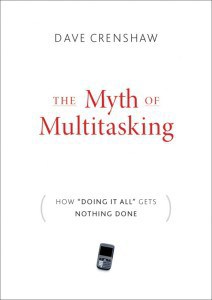 The Myth of Multitasking – Dave Crenshaw
The Myth of Multitasking – Dave Crenshaw
I am long overdue on a review of this book, which I feel bad about because I really enjoyed it. Maybe I didn't get to it because I was too busy multitasking…
First off, this is written as a business novel. Lately, I have been really weary about business novels. For one, I'm not a novel reader and, since The Goal, the only business novels I've liked and gotten through are SHORT ones, including All I Need to Know About Manufacturing I Learned in Joe's Garage: World Class Manufacturing Made Simple and The Ice Cream Maker: An Inspiring Tale About Making Quality The Key Ingredient in Everything You Do (see my review here).
This book, written by business coach Dave Crenshaw, tackles the idea of “multitasking” — that we can do two things at once. If you think about multitasking from a Lean perspective, you might think about the practices of Standardized Work. In a factory, standardized work assumes a person can really only do one thing at a time. At most, you might reach for a part with your left hand while simultaneously reaching for a tool with your right. But, this is a relatively simple task that, in a repetitive manufacturing environment, can be done without thinking and through a lot of muscle memory.
In professional settings, we often trick ourselves into thinking we can multitask. While on conference calls, people play Minesweeper or surf the web. This works, except for when you realize you haven't been listening or someone calls on you and you can't answer — it's embarrassing. Nurses and other medical professionals are often the queens (and kings) of multitasking, or so they think. Can we really do TWO things at once? Can a medical secretary really be entering data into the computer while taking a phone call?
The NY Times recently had an essay, written by a doctor, who wrote that she stuck herself with a needle from a Hep C patient because she took her glove off and reached for her pager (which was going off for the sixth time for non-urgent reasons) and hit the needle she was holding with her right hand. Justify the need to have the pager or to reach for it in the middle of patient care, the multi-tasking put the doctor's health and life in jeopardy.
Back to the book… this book, through it's story, does a good job of dispelling The Myth of Multitasking. Crenshaw makes a good case that, at best, we rapidly switch back and forth between two tasks at a time, losing attention and mental capabilities each time we switch.
In the story, the productivity coach works with a busy executive – she is convinced that she multitasks effectively, but the coach helps show her a better way. Many issues are addressed, including:
- Interruptions by colleagues during the day while you're working on something
- Electronic distractions, such as email, mobile devices, instant messaging, etc.
- Difficulty focusing on the task at hand or others who are speaking to you
- Juggling work and home at the same time
Crenshaw also addresses the “myth” that women are better multitaskers than men, sharing data that goes beyond the illustrative stories.
In the book, he shares coping mechanisms and better ways — not just highlighting the problems caused by multitasking, but also sharing what you should do.
The story is a quick, interesting read and isn't too contrived, although it's obvious the author places himself in the role of consultant. The executive character pushes back on the consultant's advice, although, as these fables and stories tend to go, she of course magically sees the light at the end of the day.
It will be thought provoking for engineers, managers, medical professionals, and any other professionals who feel “forced” into multitasking (or even those who choose to multitask, thinking they are helping their personal productivity or effectiveness).
Outside of the book, do you see multitasking as a problem for yourself or others you work with? Do you have any strategies you use to avoid or prevent multitasking? One classic one is to turn OFF the Outlook new email notification, only checking and responding to emails at certain times. Another strategy I've seen is a “do not disturb” sign on a cubicle, asking co-workers to come back if it's not urgent because the person needs to focus and concentrate on a task.
Share your thoughts in the comments – if you've read the book and want to share an opinion or if you want to share thoughts on multi-tasking.
Please scroll down (or click) to post a comment. Connect with me on LinkedIn.
Let’s work together to build a culture of continuous improvement and psychological safety. If you're a leader looking to create lasting change—not just projects—I help organizations:
- Engage people at all levels in sustainable improvement
- Shift from fear of mistakes to learning from them
- Apply Lean thinking in practical, people-centered ways
Interested in coaching or a keynote talk? Let’s start a conversation.










Mark,
IMHO, the "do not disturb" sign is a good start, but insufficient. Most of your coworkers are absolutely convinced that once your door closes, it will never open again. Or that by the time you emerge, it will be too late to solve the issue at hand.
In keeping with visual management, I find it's better to make a sign that says when you'll open the door: "do not disturb – 2:30pm" for example.
With this extra information, people can make an intelligent decision about whether the issue is urgent & important enough to disturb you, or whether it can wait for an additional 10 minutes. This information reduces the number of non-important interruptions by shifting the responsibility more clearly to your coworker.
Hi Mark
Thanks for the review!
I agree with Dan. While shutting the gate is good, shutting the gate with a clear expectation of WHEN you will be available is even better. I call this establishing a "Culture of When."
Your readers may be interested in a blog post I wrote about that:
http://www.davecrenshaw.com/blog/2008/07/a-culture-of-when/
All the best,
Dave Crenshaw
Author
The Myth of Multitasking
Dan, you might have seen this in your visits, but the Lean Enterprise Institute office practices this system, with the option of writing an "until" time. Haven't used that feature yet, but I should.
But, I'm in the Netherlands at the moment, so nobody there can disturb me if they wanted to :-)
Mark,
I taught the LEI folks to do that! Glad to hear that they haven't backslid.
That office is tough, of course, since it's totally open. I suggested using police riot tape or stuffed animals perched on cube walls to indicate that the person isn't available….
[…] author of The Myth of Multitasking: How “Doing It All” Gets Nothing Done, a book I blogged about back in 2009. Dave’s new book is called Invaluable: The Secret to Becoming Irreplaceable, a […]